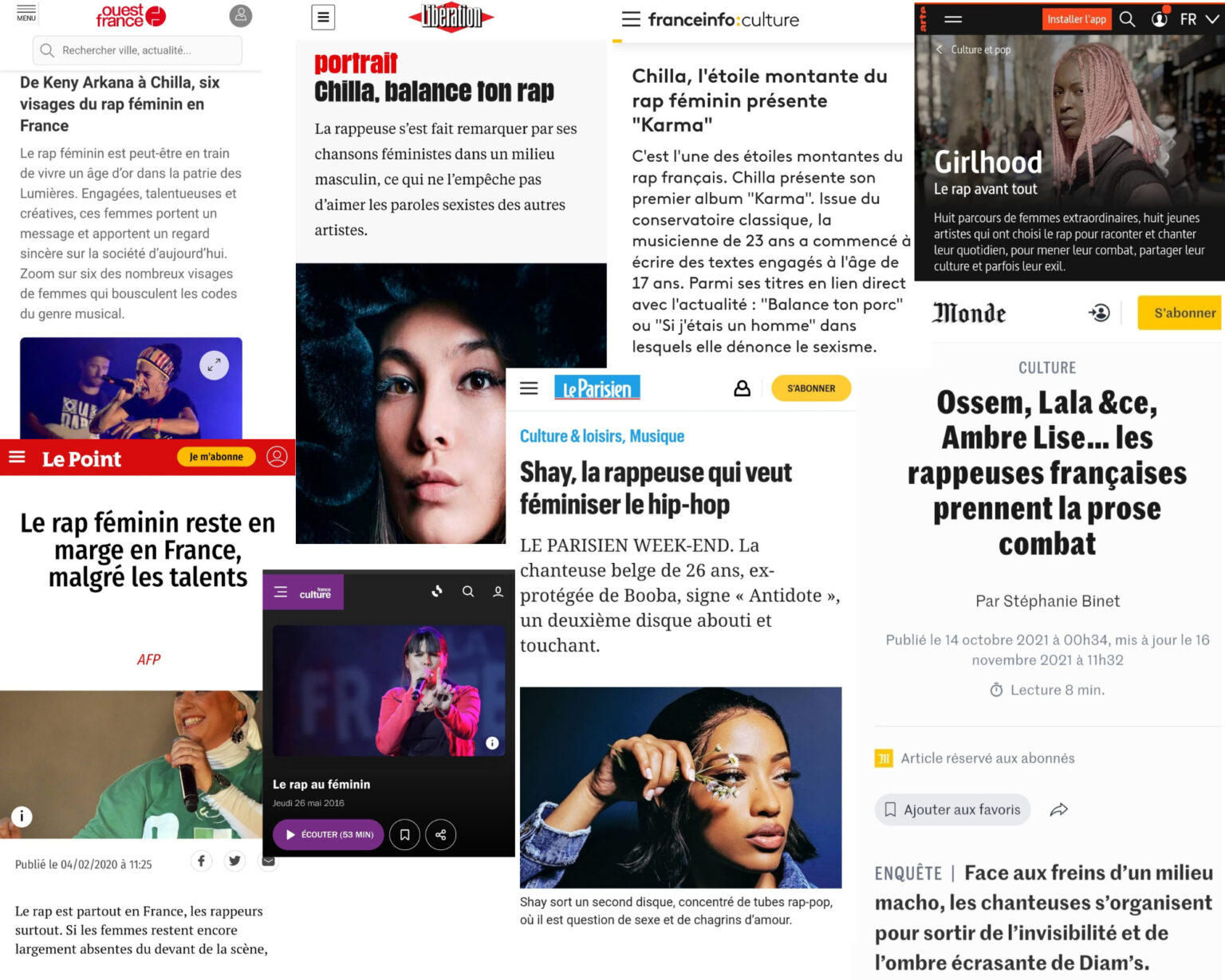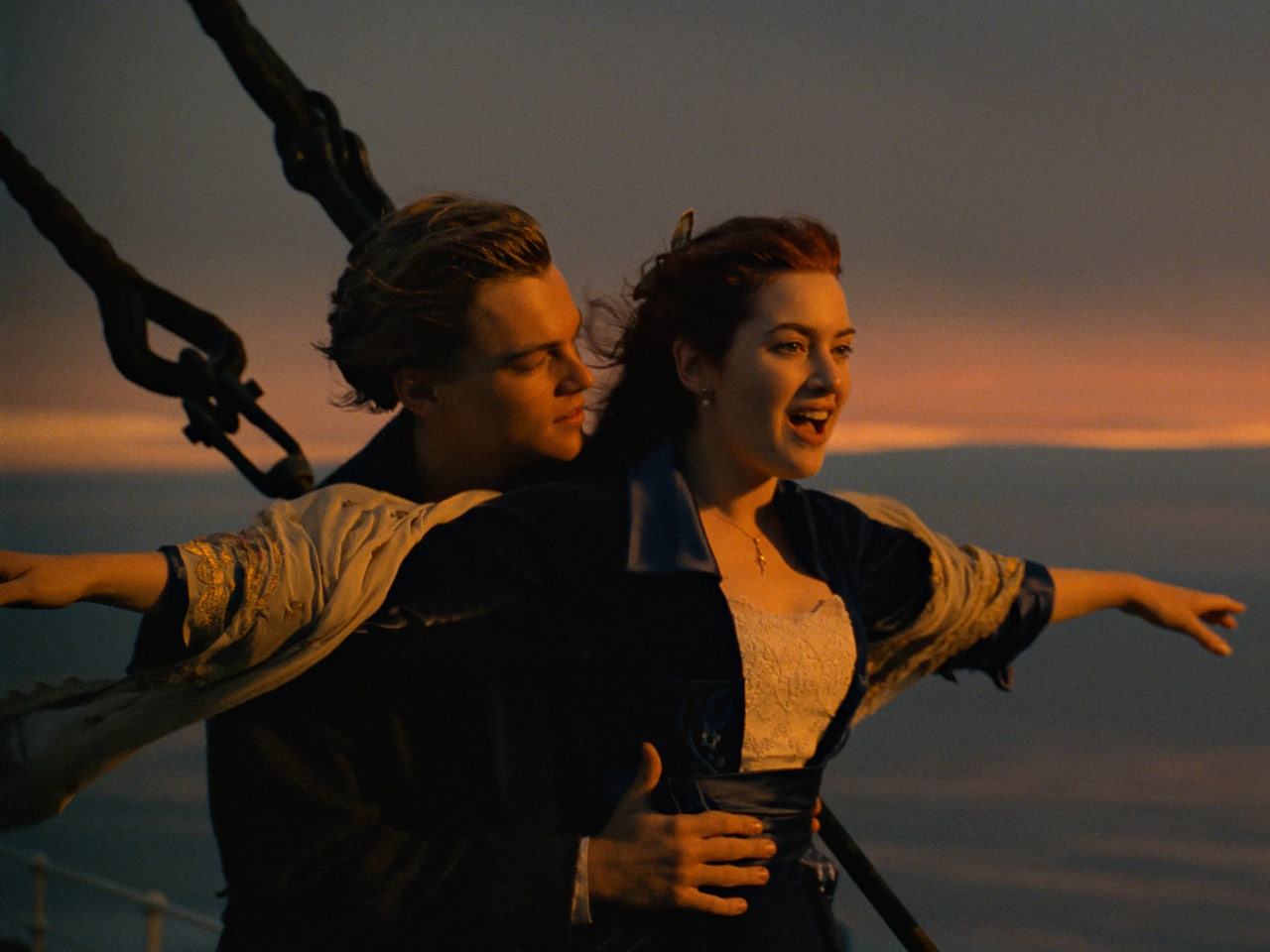The media Miss Rap, dedicated to women and LGBT+ people in hip-hop, lists around 500 female rappers, across France, Switzerland and Belgium. However, most rap lovers have a hard time naming even five. So since they exist and are full of talent, why are so few people aware of them?
To explain this paradox, the media generally emphasize the sexism of record companies, streaming platforms, the public… In short, of all links in the chain, except the media. So I asked myself the question: Does the media offer as much exposure to rappers as it does to female rappers?

3.6% of guest rappers are female rappers
To answer this question, I counted the number of times Francophone rappers were invited to 9 major hip-hop culture shows: Code on Apple Music; Click and relax, Click X AND Click Talk on Canal+; Good morning Cefran, Mouv’ Rap Club AND In front of Cefran on Mouv’ Radio (three programs that no longer exist, the schedule changed in 2022); Metropolitan legends on France 24/RFI; and finally rap planet on Skyrock (only main guests counted for this show).
The programs chosen are shows with large audiences, hosted by rap specialists and offering a long airtime to rappers. To be invited there is therefore to have the possibility ofexpress your vision and your artistic choices in front of journalists who know Hip-Hop culture inside out, often stigmatized by the mainstream media. The result is clear: of the 1,869 invitations from rappers listed to these shows, only 65 are for women, or 3.6% of invitations. This is the show Metropolitan legends which records the best score with 5 guest rappers for 67 rappers (6.9%), while Clique TV Shows is in last place with a total of 5 female rapper invites to 183 rapper invites (2.6%). It’s just below rap planet on SkyRock (2.8%). Between the two extremes we also find the three programs of Mouv’Radio Code on Apple Music, with approx 4.3% guest rappers in both cases.

The mainstream media is no exception.
What about the mainstream media? In 2018 sociologist Marion Dalibert analyzed a corpus of 581 articles on rap published between 2000 and 2015 in Le Monde, Liberation, Télérama AND Le Figaro. Conclusion : “Of the 180 artists given to see in the corpus, there are only 6 female rappers”, observes the sociologist. Again, the percentage is close to 3%.
More data was produced by researchers Karim Hammou and Marie-Sonnette Manouguian on the show Taratata (between 1993 and 2019) and the cultural mornings of France Inter (between 2009 and 2019), as part of the research carried out for the book 40 years of hip-hop music in France. This includes both invitations and streaming music. Karim Hammou has agreed to calculate the presence of rappers in this database: it is 3.3% on France Inter e 8.3% ON Taratata (a slightly higher figure than the other programmes, which can be explained in particular by the multiple invitations from Diam’s, invited 4 times).

“I’m not on the level of some male rappers of their generation”
The results of my census have been sent to each of the media concerned. Despite several email reminders, the Clique TV team and Mehdi Maïzi, host of the Code, have not responded.
Fred Musa, who hosts rap planethe emailed me this reply: “I have never set a quota for Planète Rap linked to religion, skin color, gender or anything else, I receive guests only for their artistic qualities. »
Carole Bottolier, communication delegate of Mouv’ Radio, insists on the channel’s partnerships with devices that help rappers become professionals, as well as on Radio France’s efforts for greater parity on the air. However, “there is a cultural reality which means that they are less exposed, less visible, less represented, but also less numerous! We have this concern to expose them in the best possible way, with this existing culture. But in terms of mainstream notoriety, they are not on the level of some male rappers of their generation »she says.
An argument taken up by Juliette Fievet, presenter of Metropolitan legends : “If I stuck to my specifics, which is to only have super heavy artists who are a hit, who can be classified as legends, I would hardly be doing rap. If I had to wait for them to go platinum before inviting them, I would never receive them. So I’m already making exceptions. »
Should we wait for an artist to be famous to exhibit him or is it really the role of the media to make him known? In the case of female rappers, one can only express fears that music industry prejudices will be reproduced if the media will only act as an echo chamber of top charts.

Female rappers suffer from reductive framing from the media
Another recurring argument between my interlocutors: there are very few female rappers, so this weak presence is mechanically reflected in the media.
However, according to an estimate by sociologist Karim Hammou, based on the Genius site discographies between 2005 and 2018, rap works created by women would represent about 5% of the overall production. It is therefore higher than the average share of female rappers invited to the 9 rap programs studied, as well as to the France Inter morning shows. According to Karim Hammou, these observations lead to the conclusion that the media field also bears its share of responsibility, “not only in the invisibility, but also in the reductive framing that rappers are subjected to”.

The Straitjacket of “Female Rap”
In fact, there are questions that are asked only to female rappers: “Are you a feminist? », « Is it difficult to be a woman in rap? » they’re almost inevitable, when you don’t ask them if they might sacrifice their careers for love or if they wouldn’t dream of “a big beautiful wedding.”“Rappers are rarely asked about their music, but rather about their genre, or the fact that it’s incredible for a woman to evolve in rap, an environment considered much more sexist than politics, technology or sports. Where, of course, the gender of rappers is never a topic since masculine is the “norm”summarizes Eloïse Bouton, founder of Miss Rap.

Even though it is used less and less, some journalists continue to use the term “female rap”, despite being rejected by the majority of female rappers, who not only it denies their ability to reach a large audience, but also implies that there would only be room on the music scene for one rapper at a time, the “new Diam’s”. Vicky R recently protested this category in her song “Fuck the female rap”.

” To always bring ourselves back to the fact that we are women is to get away from the subject. And the argument is that we are talented artists “, Chilla summed up in an interview. Period.
Source: Madmoizelle
Mary Crossley is an author at “The Fashion Vibes”. She is a seasoned journalist who is dedicated to delivering the latest news to her readers. With a keen sense of what’s important, Mary covers a wide range of topics, from politics to lifestyle and everything in between.



